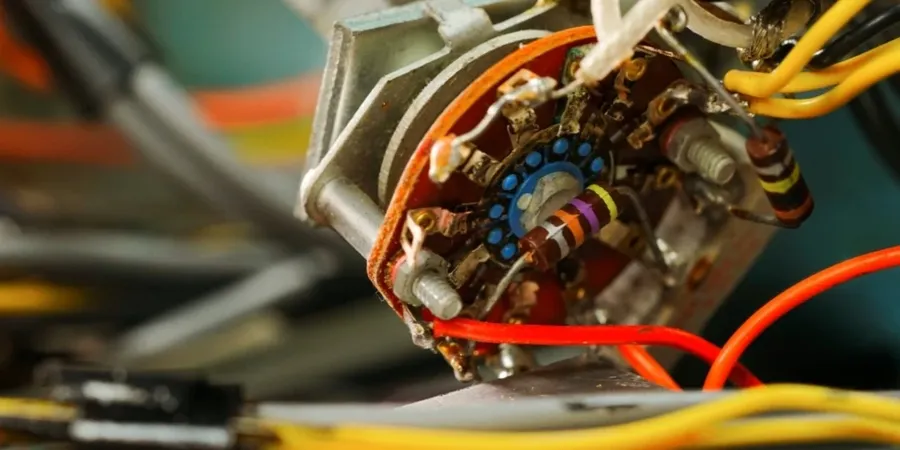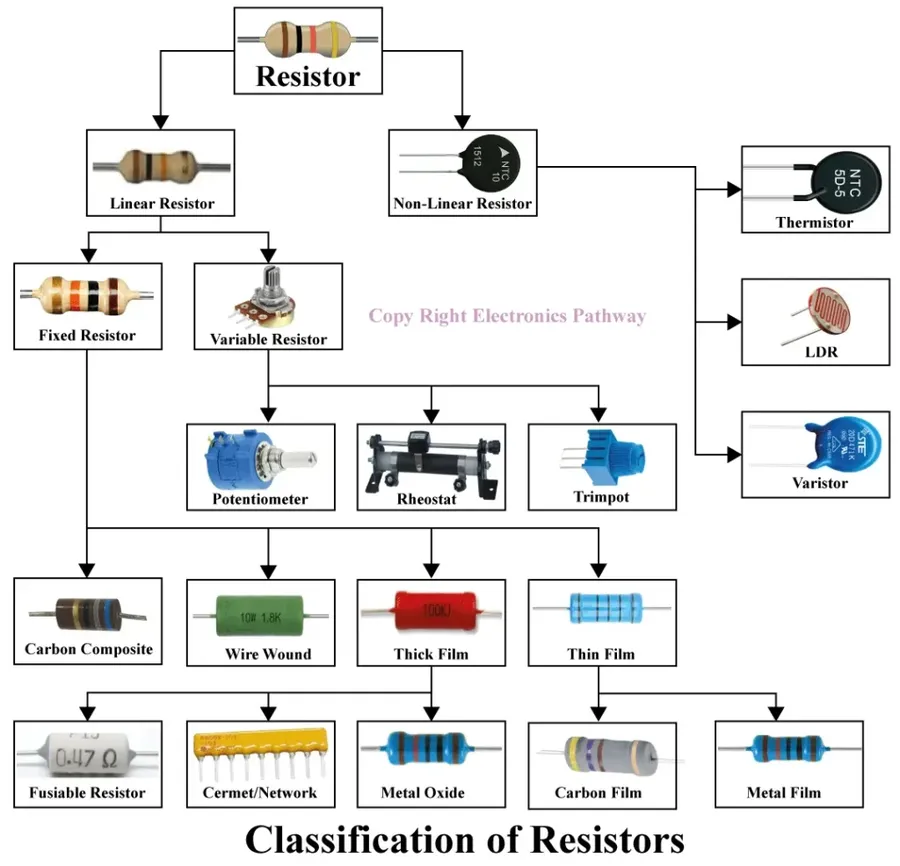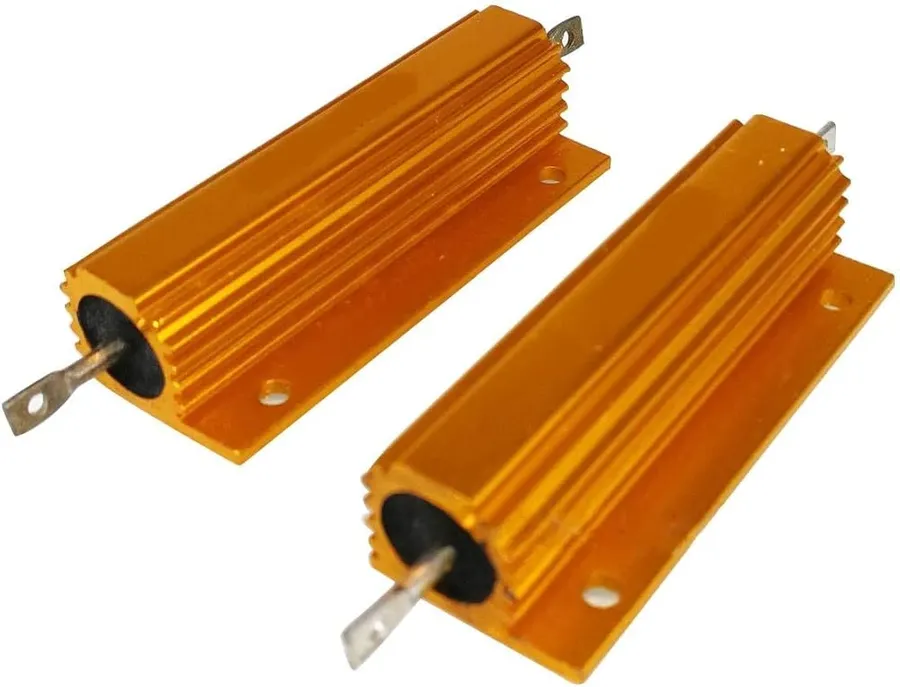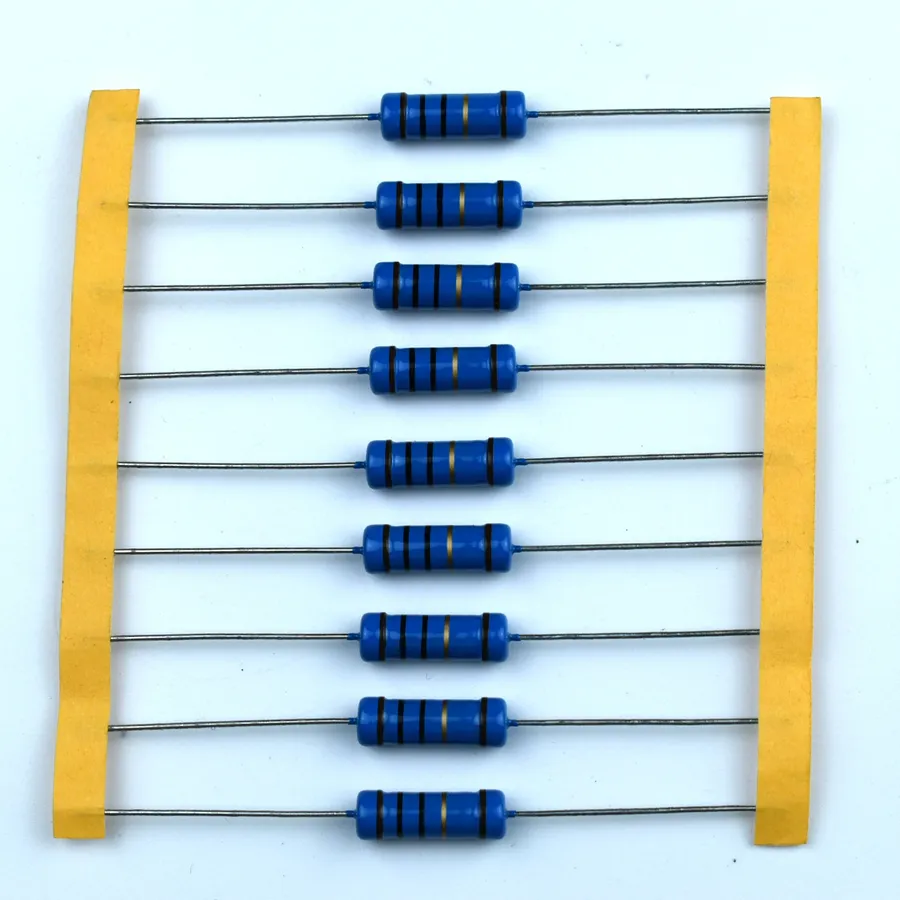Understanding the 500 Ohm Resistor: Applications, Types, and Selection

The seemingly simple 500 ohm resistor is a fundamental building block in countless electronic circuits, much like the silent workhorses of our society. From everyday gadgets to complex industrial systems, this component plays a crucial role in managing electrical current. In this article, we'll delve into the applications of 500 ohm resistors, examining their various types, and offering guidance on how to select the ideal resistor for your project. We'll also explore common use case of 500 ohm resistors in 4-20mA to 2-10V signal conversions. It's more than just a tiny component; it's a vital piece of our technological landscape.
What is a 500 Ohm Resistor and How Does It Work?

A 500 ohm resistor is a fundamental passive electronic component designed to impede the flow of electrical current by 500 ohms. This resistance, quantified by Ohm's Law (V=IR), determines the relationship between voltage (V), current (I), and resistance (R). The resistor's primary function is to limit current, ensuring that the current within a circuit does not exceed design specifications and thereby preventing damage to other components.
Common Applications of 500 Ohm Resistors

500 ohm resistors serve as versatile components across numerous electronic applications, primarily functioning in signal conditioning, current control, and voltage division. They are critical in various circuits, notably within industrial control systems and sensor interfaces, effectively transforming electrical signals for optimal circuit performance. A common use is the conversion of 4-20mA current loop signals into a 2-10V voltage signal, a standard practice in industrial automation for signal compatibility and ease of processing.
- Signal Conditioning
Used to modify signals by reducing noise, changing the amplitude, or filtering frequencies to prepare them for processing or transmission. - Current Limiting
These resistors limit the flow of current in a circuit to prevent damage to sensitive components by restricting the current to a safe level. - Voltage Division
When placed in series, 500 ohm resistors, along with other resistors can reduce a voltage to a useable level by dividing the voltage across two or more resistors. This is done using the the voltage divider principle where the ratio of resistance creates a proportion of the input voltage. - 4-20mA Current Loop Conversion
In industrial automation, a 500 ohm resistor converts a 4-20mA current signal into a 2-10V voltage signal. This is a common practice for integrating industrial sensors and control equipment. - Sensor Interface Circuits
Used in sensor interface circuits to provide a stable voltage or current signal and prevent damage to the sensor, also to ensure the output signal is within a useable range. - Industrial Control Systems
Commonly found in industrial control systems for various purposes such as controlling servo motors, actuator control, and power monitoring devices to allow for reliable automation.
| Application | Function | Benefit |
|---|---|---|
| Signal Conditioning | Modifies signal characteristics | Improves signal quality for processing |
| Current Limiting | Controls the current flow | Protects sensitive components from overcurrent |
| Voltage Division | Reduces a voltage to useable level | Allows for the use of sensors and circuits that require a low voltage. |
| 4-20mA Conversion | Converts current to voltage | Enables compatibility between current-based sensors and voltage-based systems |
| Sensor Interface | Provides stable signal | Ensures reliable sensor operation and prevents damage. |
| Industrial Controls | Power and signal control | Enables reliable automation |
Types of 500 Ohm Resistors

500 ohm resistors are available in various forms, each engineered for specific applications and performance requirements. These different types primarily vary in construction, materials used, and mounting methods, influencing their characteristics such as power handling, precision, and operating temperature range. The selection of the appropriate type is essential for optimal circuit performance.
| Resistor Type | Construction | Typical Applications | Advantages | Disadvantages |
|---|---|---|---|---|
| Through-Hole (Axial Lead) - Carbon Film | Thin carbon film deposited on a ceramic substrate, with leads for insertion into a PCB. | General-purpose applications, prototyping, low-cost designs. | Low cost, widely available, suitable for low-power circuits. | Less precise than metal film, higher temperature coefficient, susceptible to drift over time. |
| Through-Hole (Axial Lead) - Metal Film | Thin metal film deposited on a ceramic substrate, with leads for insertion into a PCB. | Precision circuits, instrumentation, audio equipment. | Higher precision, lower temperature coefficient, lower noise. | More expensive than carbon film, limited power handling compared to wirewound. |
| Through-Hole (Axial Lead) - Wirewound | A resistive wire wound around a ceramic core, with leads for insertion into a PCB. | High-power applications, current sensing, braking resistors. | High power handling capacity, excellent surge protection, stable at high temperatures. | Large physical size, can be inductive, not suitable for high-frequency applications. |
| Surface Mount (SMD) Resistors | Thick or thin film resistive material deposited on a ceramic substrate, with terminals for surface mounting. | High-density PCB designs, automated assembly, mobile devices. | Small size, low profile, easy for automated assembly. | Lower power rating than through-hole, more difficult to handle without proper tools, higher initial cost. |
| Cement Resistors | Wirewound resistors encased in a ceramic or cement material. | High-power, heat dissipation applications, commonly used in power supplies and motor controls. | High power handling and excellent heat dissipation. | Physically large and not precise compared to other types. |
Selecting the Right 500 Ohm Resistor: Key Factors

Selecting the appropriate 500 ohm resistor for a specific application is crucial for circuit performance and reliability. Several key factors must be considered to ensure the resistor meets the circuit's requirements without compromising its function or longevity. These include power rating, tolerance, temperature coefficient, and physical characteristics such as size and mounting style.
| Factor | Description | Importance |
|---|---|---|
| Power Rating (Wattage) | The maximum power the resistor can dissipate as heat without damage. It's determined by the expected current flow through the resistor and the voltage drop across it. | Critical for preventing overheating and resistor failure. Exceeding power rating can cause damage or fire. |
| Tolerance (Accuracy of Resistance) | The allowable deviation of the actual resistance from the nominal value (500 ohms). Usually expressed as a percentage, common tolerances are ±1%, ±5%, and ±10%. | Impacts the accuracy of the circuit. Lower tolerance resistors are needed for precision circuits while higher tolerances are acceptable for non critical circuits. |
| Temperature Coefficient | How much the resistance changes with temperature, it is expressed in ppm/°C (parts per million per degree Celsius). | Important in environments where the temperature varies, as resistance will drift from the nominal value. |
| Physical Size and Mounting | The dimensions of the resistor and how it's mounted (e.g., through-hole, SMD). | Affects the physical layout of the circuit board and is limited by the size and layout constraints. Proper mounting also ensures correct thermal dissipation. |
Understanding Resistor Color Codes for 500 Ohm Resistors

While surface mount (SMD) resistors utilize numerical codes, through-hole resistors often employ color bands to indicate their resistance value. A 500 ohm resistor is typically coded with four bands: green, black, brown, followed by either a gold or silver band to indicate tolerance. This section will detail how to interpret these color codes.
| Band | Color | Value | Multiplier | Tolerance |
|---|---|---|---|---|
| 1st Band | Green | 5 | - | - |
| 2nd Band | Black | 0 | - | - |
| 3rd Band | Brown | - | 10 | - |
| 4th Band | Gold | - | - | 5% |
| 4th Band | Silver | - | - | 10% |
The first two bands represent the significant digits of the resistance value. The third band is the multiplier which in the case of a brown band, means multiply by 10. The fourth band indicates the tolerance, with gold representing 5% and silver representing 10%. Thus a resistor with a sequence of green, black, brown, gold band will be 50 x 10 = 500 ohms at 5% tolerance.
500 Ohm Resistors in 4-20mA Current Loop Systems

The 500 ohm resistor is a crucial component in 4-20mA current loop systems, serving as a precision current-to-voltage converter. This conversion is fundamental for interfacing industrial sensors and other devices that transmit data via current signals into control systems or data acquisition hardware that often requires voltage inputs.
In such a system, a 4-20mA current signal, representing a measured variable (e.g., temperature, pressure), flows through the 500 ohm resistor. According to Ohm's Law (V = I * R), a proportional voltage drop is developed across the resistor. This voltage drop ranges from 2V (0.004A * 500 ohms) to 10V (0.02A * 500 ohms), creating a 2-10V voltage signal that represents the transmitted data. This standardized voltage signal is then readily compatible with various analog-to-digital converters and control circuitry.
| Current (mA) | Resistance (Ohms) | Calculated Voltage (V) |
|---|---|---|
| 4 | 500 | 2 |
| 20 | 500 | 10 |
The precision of the 500 ohm resistor is critical in these applications. The resistor's tolerance directly influences the accuracy of the converted voltage signal. For example, a resistor with 1% tolerance will introduce less error in the voltage reading compared to one with 5% tolerance. Moreover, the temperature coefficient of the resistor should be considered, as its resistance can slightly vary with temperature, which can impact the precision of the conversion.
Frequently Asked Questions about 500 Ohm Resistors
This section addresses common questions about 500 ohm resistors, providing clear and concise answers to help users understand their properties, applications, and usage in electronic circuits. These frequently asked questions offer practical insights into the function and selection of 500 ohm resistors.
- What are the typical applications of a 500 ohm resistor?
500 ohm resistors are commonly used for signal conditioning, current limiting, and voltage division in electronic circuits. They are also frequently found in industrial automation, specifically in 4-20mA current loop systems for converting current signals to voltage signals, and in sensor interfaces to provide a known resistance for signal processing. - What is the color code for a 500 ohm resistor?
The color code for a 500 ohm resistor is typically: Green, Black, Brown, and then either Gold (for 5% tolerance) or Silver (for 10% tolerance). The first three bands represent the resistance value, and the fourth band represents the tolerance. Note that Surface Mount resistors do not have a color code. - How does a 500 ohm resistor limit current in a circuit?
According to Ohm's Law (V = IR), a resistor provides a specific level of resistance to current flow. In a circuit with a constant voltage, increasing the resistance will result in a decrease in current, and vice-versa. A 500 ohm resistor therefore limits the current by opposing the flow of electrons, thus reducing the magnitude of the current that can pass through the component. - What does the wattage rating of a 500 ohm resistor indicate?
The wattage rating of a resistor indicates the maximum power the resistor can dissipate as heat without being damaged. Selecting the correct wattage for a 500 ohm resistor is crucial to avoid thermal damage. If the resistor has a wattage rating that is too low for the power requirements, it may overheat and fail. Common wattage ratings include 1/8W, 1/4W, 1/2W, 1W, and 2W etc. - Why is a 500 ohm resistor used in 4-20mA current loops?
In 4-20mA current loops, a 500 ohm resistor converts the current signal to a 2-10V voltage signal, in accordance to Ohm's Law (V=IR). This voltage signal is then easier for many industrial control systems to measure and use. In essence, this allows a very stable current signal to be converted into a more usable voltage signal, which can then be processed by analog to digital converters, or other measurement devices. - What factors should be considered when selecting a 500 ohm resistor?
Key factors include: the power rating (wattage), to ensure it does not overheat; the tolerance (the accuracy of resistance), to fit within design specifications; the temperature coefficient, which affects how the resistance changes with temperature; and the physical size and mounting requirements, to accommodate the physical design of the circuit. - Can a 500 ohm resistor be used as a voltage divider?
Yes, a 500 ohm resistor can be used as part of a voltage divider circuit. The voltage across each resistor in a series circuit is proportional to their resistance. In voltage dividers, the 500 ohm resistor can help in reducing the voltage to a suitable level for a specific component or part of a circuit.
Practical Tips for Working with 500 Ohm Resistors
Successfully integrating 500 ohm resistors into electronic circuits requires attention to detail, proper handling techniques, and adherence to best practices during soldering and connection processes. These guidelines help ensure the longevity and reliability of your circuits.
- Soldering Precautions
When soldering 500 ohm resistors, apply heat quickly to minimize thermal stress, which can alter the resistor's value or cause physical damage. Use a temperature-controlled soldering iron and ensure that solder joints are smooth and properly wetted to guarantee reliable electrical connections. A good practice is to use flux to aid in the wetting process. - Handling and Storage
Store 500 ohm resistors in a dry, temperature-controlled environment away from direct sunlight and excessive moisture to prevent corrosion or changes in resistance. Always handle resistors by their body or leads, avoiding direct contact with the resistive element. Do not bend the leads excessively to avoid weakening the connection, and use tweezers when handling surface mount resistors to prevent damage. It's advisable to store resistors in anti static packaging. - Checking Tolerances
Before incorporating a 500 ohm resistor, verify its resistance using a digital multimeter to ensure it falls within its stated tolerance range. It's critical for precise circuit operation. Most common resistors have a tolerance of 5% or 1% so a 5% 500 ohm resistor will have a resistance between 475 ohms and 525 ohms. The tolerance is indicated by the last color band on a through hole resistor. - Making Appropriate Connections
Ensure that the 500 ohm resistor is properly connected to the circuit using the correct polarity if applicable (although resistors are generally non-polar). Connections must be mechanically secure. Secure connections can be made by soldering directly to pads on a PCB or with a connector, which ensures a reliable connection that is vibration and mechanical movement resistant. - Power Rating Considerations
Always consider the power rating of the 500 ohm resistor to ensure that it can handle the expected current and voltage. Calculate the power dissipation using the formula P = I²R or P = V²/R to make sure that the power is within the resistor's rating. Failing to do this may cause damage to the resistor and potentially the circuit.
500 Ohm Resistor vs Other Resistors: Understanding the Differences
The core distinction between a 500 ohm resistor and other resistors lies in their resistance value, which directly impacts their behavior within an electrical circuit. Resistance, measured in ohms (Ω), dictates how much a resistor impedes the flow of electrical current. A higher resistance results in a lower current flow, and vice versa, following Ohm's Law (V=IR).
| Resistor Value | Impact on Current (at constant voltage) | Common Applications | Key Differences |
|---|---|---|---|
| 100 Ohm | Higher current flow compared to 500 ohm and 1k ohm | Current limiting in LED circuits, shunt resistors in current measurement | Allows more current, causes more energy to be lost as heat compared to higher resistance |
| 500 Ohm | Moderate current flow; lower than 100 ohm and higher than 1k ohm | 4-20mA to 2-10V conversions, signal conditioning, precise current limiting | Balances current limitation and voltage drop, suitable for signal processing |
| 1k Ohm | Lower current flow compared to 100 ohm and 500 ohm | Pull-up/pull-down resistors, protection in digital circuits, voltage dividers | Limits current more, reduces heat generation, suitable in situations requiring lower current |
When comparing 500 ohm resistors to others, such as 100 ohm and 1k ohm resistors, the difference in current flow is significant. For instance, given a constant voltage source, a 100 ohm resistor will allow significantly more current to pass through it than a 500 ohm resistor. Conversely, a 1k ohm resistor would allow the least current to pass through. This is directly attributed to the inverse relationship between resistance and current at a constant voltage. The practical upshot of this is that lower resistance resistors will require larger watt ratings to dissipate heat caused by current, compared to higher resistance resistors which have less current flow.
In essence, the choice of resistor value hinges on the circuit's specific requirements. A 500 ohm resistor is a good middle ground, providing a balance between limiting current and voltage drop, making it useful in signal processing applications. The application will determine if you need more or less resistance in the circuit. This affects both the current through a component and voltage across the component. Higher the resistance, the lower current at the same voltage and higher the voltage drop.
In conclusion, the 500 ohm resistor, much like the silent 500 ohm resistor in a critical circuit, is a critical component in the electronic world, offering a versatile tool for current management and signal processing. Understanding its applications, types, and selection criteria is key for both professional engineers and hobbyists. From 4-20mA to 2-10V conversions, and in everything from basic electronics circuits to complex industrial systems, a 500 ohm resistor serves a multitude of purposes. As our technology advances, the humble 500 ohm resistor is likely to remain an essential piece of our electronic landscape, continuing to quietly ensure the smooth operation of the tech that surrounds us.
 AnyPCBA
AnyPCBA